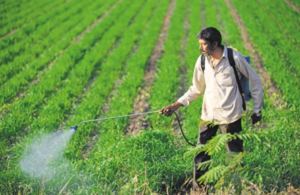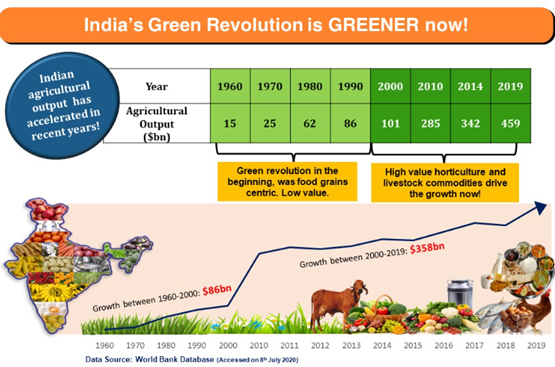Green Revolution Transformed Indian Agriculture
Relevance
- GS 3: Major Crops – Cropping Patterns in various parts of the country
- Tags: #GreenRevolution #MSSwaminathan # Agriculture #UPSC #CurrentAffairs
Why in the News?
The Green Revolution, pioneered by agricultural scientist M.S. Swaminathan, marked a transformative era in India’s agriculture, significantly boosting crop yields and addressing food security challenges.
What is Green Revolution?
The Green Revolution in India refers to a period of rapid and significant agricultural transformation that took place in the country during the mid-20th century, primarily from the 1960s to the 1980s. It was a set of initiatives and technological advancements aimed at increasing agricultural productivity and food grain production in India.
Situations and issues that contributed to the Green Revolution
Food Shortages
- India was grappling with chronic food shortages and famine-like conditions in the 1950s and early 1960s.
- The existing agricultural practices were unable to keep up with the growing population’s food demands.
Dependence on Food Aid
- India was heavily reliant on food aid from foreign countries, particularly the United States under the PL-480 program.
- This dependence raised concerns about food security and sovereignty.
Low Agricultural Productivity
- Traditional farming methods, including the use of age-old seed varieties and outdated farming techniques, led to low agricultural productivity.
- Crop yields were far from sufficient to meet the country’s needs.
Population Growth
- India’s population was growing rapidly, adding to the pressure on the agricultural sector to produce more food.
Vulnerable to Weather
- Agriculture in India was highly vulnerable to weather conditions, particularly droughts and monsoon failures.
- Crop losses due to unpredictable weather were common.
Need for Technological Advancements
- There was a recognized need for modernization and the adoption of advanced agricultural technologies to increase crop yields and reduce vulnerability to weather.
How Green Revolution Began?
The Green Revolution in India was a comprehensive agricultural transformation that began in the 1960s and significantly increased agricultural productivity.
Leadership
- M.S. Swaminathan: a central role in promoting the Green Revolution in India.
- His leadership in developing high-yielding variety (HYV) seeds and advocating for modern farming practices was instrumental.
Technological Advancements
- High-Yielding Variety (HYV) Seeds: Norman Borlaug, an American scientist, developed wheat varieties with higher yields.
- Irrigation Techniques: Improved irrigation methods, including the construction of canal systems and tube wells, were introduced to ensure water availability.
Financial Assistance
- Ford Foundation and Rockefeller Foundation: These international organizations provided substantial financial and technical support for agricultural research and development.
- Their assistance facilitated the initial experiments with HYV seeds.
Pilot Projects
- The Green Revolution’s success began in the northwestern states of Punjab and Haryana.
- Pilot projects there showcased the potential of HYV seeds and modern farming techniques.
Policy Changes
- Government leaders like Subramaniam, the Minister for Agriculture, actively supported and implemented policies that favored the Green Revolution.
- Financial Incentives: The government introduced subsidies on fertilizers, credit facilities for farmers, and support for building infrastructure like dams and canals.
Private Sector Participation
- Private sector companies, such as the Punjab-based Punjab Agro Industries Corporation (PAIC), played a role in producing and distributing HYV seeds.
Extension Services
- Krishi Vigyan Kendras (KVKs): These agricultural extension centers were established to provide farmers with the latest agricultural practices and technologies.
Success and Expansion
- The initial success in Punjab and Haryana encouraged the spread of the Green Revolution to other states like Uttar Pradesh, Andhra Pradesh, and Tamil Nadu.
Impact of Green Revolution
| Positive Impact | Negative Impact |
| 1. Increased Agricultural Productivity
o The Green Revolution led to a significant increase in crop yields, particularly for wheat and rice, which are staple foods in India. o For instance, wheat yields per hectare increased from about 0.8 tons to 4-6 tons.
2. Food Security o Higher crop yields ensured greater food availability, reducing the risk of famine and improving food security for millions of people.
3. Increased Agricultural Research o The Green Revolution stimulated greater investment in agricultural research and development. o leading to further innovations in crop breeding and farming practice
4. Rural Development o The increased agricultural income and productivity led to rural development. o It improved the living standards of farmers and contributed to poverty reduction.
5. Employment Generation o The expansion of agricultural production created job opportunities in rural areas, reducing urban migration.
6. Technological Advancements o The Green Revolution introduced modern farming techniques, including improved seeds, fertilizers, and irrigation methods, which increased the efficiency of agriculture. 7. Export Opportunities o Surpluses in food production allowed India to become an exporter of agricultural commodities like rice, wheat, and cotton. |
1. Income Inequality
o Large landowners and wealthy farmers were better equipped to adopt new technologies. o While small and marginal farmers faced challenges, leading to income inequality.
2. Environmental Concerns o The excessive use of chemical fertilizers and pesticides led to soil degradation, water pollution, and environmental damage. o It also harmed non-target organisms and disrupted ecosystems.
3. Depletion of Natural Resources o Intensive farming practices depleted groundwater resources due to over-irrigation, leading to a decline in the water table in some regions.
4. Crop Monoculture o The focus on high-yielding varieties of a few crops, such as wheat and rice, resulted in a shift toward crop monoculture, o Reducing crop diversity and increasing vulnerability to pests and diseases.
5. High Production Costs o The adoption of modern technologies increased production costs for farmers, making them dependent on external inputs, such as seeds, fertilizers, and pesticides.
6. Social Disparities o The Green Revolution contributed to social disparities, with wealthier farmers benefiting more from the technology, exacerbating income and land ownership disparities.
7. Debt and Dependency o Some farmers who adopted modern farming practices became dependent on expensive inputs like seeds, fertilizers, and pesticides o In cases of crop failure, they fell into debt, creating a cycle of dependency. |
Schemes and programs associated with the Green Revolution
High-Yielding Varieties Program (HYVP)
- Year: 1966
- Objective: To introduce and promote the cultivation of high-yielding varieties (HYV) of wheat and rice.
- Significance: Led to a substantial increase in wheat and rice production and served as the cornerstone of the Green Revolution in India.
Intensive Agricultural District Program (IADP)
- Year: 1960-1961
- Objective: To identify and develop selected districts with the potential for intensive agricultural development.
- Significance: Focused on improving irrigation, soil management, and the adoption of HYV seeds.
National Demonstration Program (NDP)
- Year: 1960s
- Objective: To demonstrate the benefits of modern agricultural practices, including the use of HYV seeds and fertilizers, to farmers.
- Significance: Increased farmer awareness and adoption of new technologies.
Agricultural Prices Commission (APC)
- Year: 1965
- Objective: To ensure remunerative prices for agricultural produce to incentivize farmers to adopt modern techniques.
- Significance: Provided price support and stability to farmers, encouraging them to invest in Green Revolution practices.
Watershed Development Programs
- Year: 1970s
- Objective: To manage water resources effectively through the construction of small dams, check dams, and terracing.
- Significance: Helped improve water availability and soil conservation, especially in rainfed areas.
Seed Replacement Programs
- Year: 1960s-1980s
- Objective: To replace traditional crop varieties with high-yielding and disease-resistant seeds.
- Significance: Contributed significantly to increasing crop yields and reducing vulnerability to pests and diseases.
Key Institutions Set Up to Support Green Revolution
Indian Council of Agricultural Research (ICAR)
- ICAR was established in 1966 as an autonomous organization under the Ministry of Agriculture.
- It coordinates agricultural research and education in India, including the development of high-yielding crop varieties and modern farming techniques.
National Seeds Corporation (NSC)
- NSC was established in 1963 to produce and distribute high-quality seeds of improved crop varieties developed during the Green Revolution.
- It played a crucial role in ensuring that farmers had access to the new seeds.
National Bank for Agriculture and Rural Development (NABARD)
- NABARD was set up in 1982 to provide financial support to agriculture and rural development initiatives.
- It played a significant role in channeling credit to farmers for purchasing seeds, fertilizers, and machinery.
Indian Farmers Fertilizer Cooperative Limited (IFFCO)
- IFFCO was formedin 1967, as a cooperative society to manufacture and distribute fertilizers to farmers.
- It ensured the availability of fertilizers needed to complement high-yielding crop varieties.
Food Corporation of India (FCI)
- FCI was set up in 1965, responsible for procuring surplus grain produced as a result of the Green Revolution and distributing it across the country.
- This helped stabilize food prices and ensure food security.
The Green Revolution in India has been a game-changer in the nation’s agriculture and food security landscape. While it achieved remarkable success in boosting food production and alleviating poverty, it also raised significant challenges related to environmental sustainability and income disparities. As India moves forward, it must strike a balance between productivity and sustainability to ensure a greener and more prosperous future for its agriculture sector.
Source: Indian Express, Mint, Business Standards
Mains Question
Discuss the key factors and technological interventions that characterized the Green Revolution in India. How did this revolution impact India’s agricultural productivity and food security?





